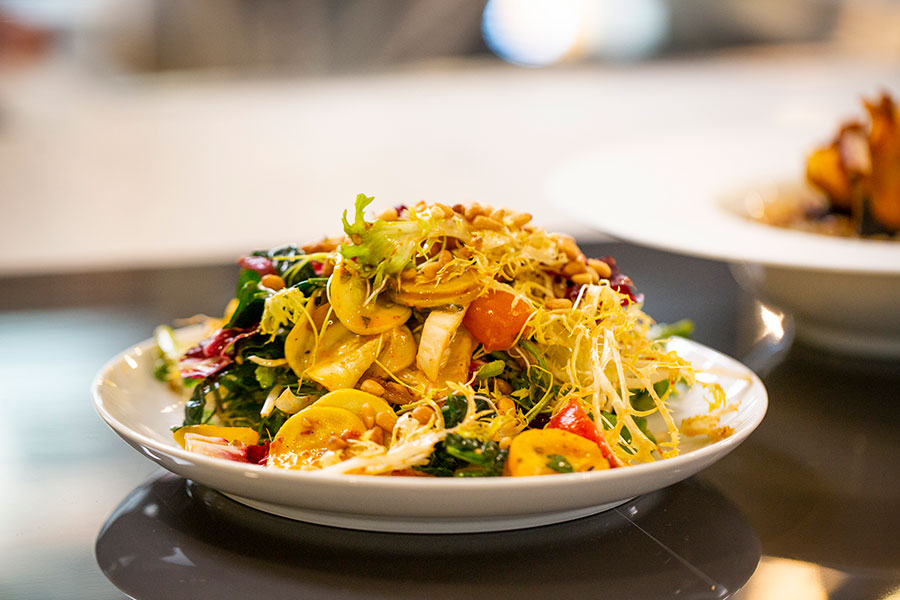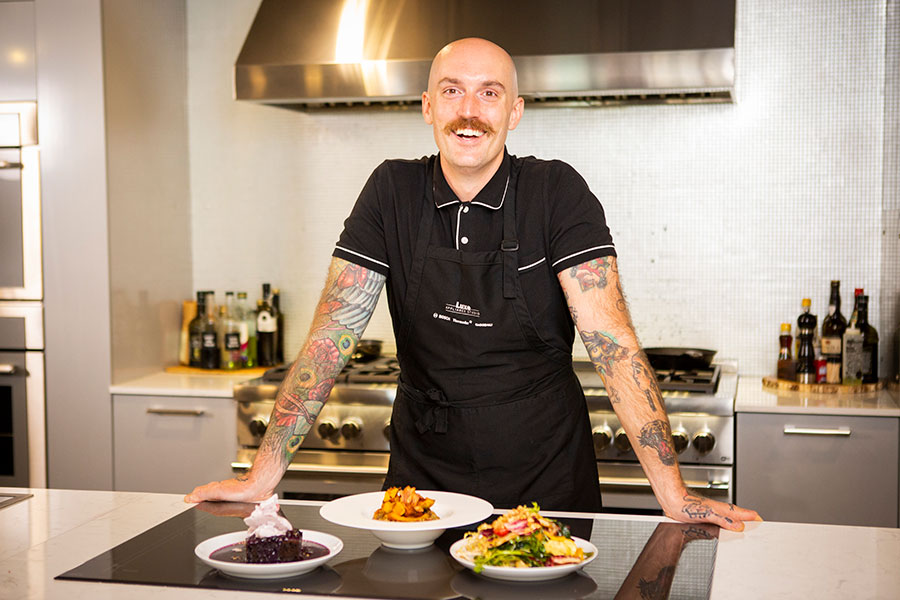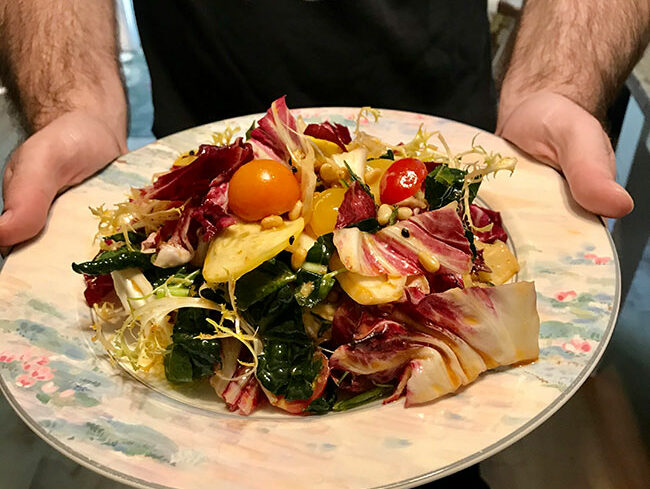Get Your Veg On! Plant-Based Recipes a Carnivore Will Love

Chef Matthew Ravenscroft shares some of his favourite plant-based recipes including one for his famous Bitter Greens Salad. Photo: Courtesy Thermador
My whole life people would describe my eating habits as carnivorous. My ideal meal usually includes a perfectly cooked steak or a couple of cheeseburgers, preferably grilled by my own hand. As someone with a Mediterranean background, we of course enjoy our veggies, nearly always having a kind of salad or dip. But, for me, meat or some sort of protein like chicken or fish is the “crown jewel” of the meal. They even joke about this in the first My Big Fat Greek Wedding film, when the family finds out the groom-to-be is a vegetarian. “No meat? It’s okay. We make lamb then,” is their answer, not quite understanding this foreign vegetarian concept.

But one thing my Mediterranean diet does have in common with the plant-forward cooking style of chef Matthew Ravenscroft of Rosalinda, a vegan restaurant in Toronto, is the necessity for the meals to be fresh and cooked with love. So when the invitation came for a virtual interactive cooking webinar with chef Ravenscroft, in partnership with the latest kitchen appliances from Bosch, Thermador and Gaggenau, to learn fresh new ways to enjoy plant-based cooking, I was happy to join my mum, Vivian Vassos, the executive editor at Zoomer, to get cooking. And when it came to cooking fresh and with love, there was plenty of both in my session with the acclaimed chef. And the meatless meal ended up being a delicious winner! (See below for the recipes)
Speaking of big fat Greek families, with only a couple of mixing bowls, a pot, a skillet and a rubber spatula, my mother, my grandmother and I ventured into the unknown. The first recipe Ravenscroft had set for the day was a classic starter for any meal — a bitter green salad — reinforced and reinvigorated by an excellent array of unique ingredients including zucchini, pine nuts, roasted fennel and garlic tomatoes, with a balsamic and olive oil dressing. My grandmother and I tossed all this freshness together in a mixing bowl and, much to her delight, just as Ravenscroft had done, we tossed it by hand. It was a fun experience for me as I had never tossed a salad by hand, and clearly my grandmother was having a great time. That prep style made the dish more personal and earthy to be able to “feel” the ingredients. The dish was a tasty wedding of plant-based flavours with no ingredient overpowering any other, but I did have a favourite — the roasted fennel pushed it up an extra notch with its smokiness while almost adding a protein-like crunch to the dish.
I got a kind of double lesson out of the main course: farro risotto with grilled leeks and parsnip-cashew cream. I had never cooked a risotto before and always wanted to learn, let alone with farro grain rather than the usual arborio rice. My grandmother, my mother and I all took turns adding broth and the ingredients and mixing it all up. We really started to get our groove in the kitchen as our farro slowly gained that delicious creamy texture that makes a risotto what it is. One thing Chef Ravenscroft also stressed with the risotto was to keep tasting it to check your process, to see if you need salt, etc. This is not only tasty fun but, particularly with this dish, we wanted to get it perfect.
There was one more important ingredient to the risotto that kept us wondering as we were cooking; half a roasted seasoned kabocha squash. This would end up being our plant-based meat substitute. Ravenscroft instructed us to grill up the squash on a skillet with vegetable oil, just as you would with a steak. The squash had been pre-roasted upon arrival and was seasoned with oil and salt. Normally squash would be one of the least likely ingredients I’d cook with, but this experience changed my mind completely. The squash came out very well, grill lines and all. We topped our farro risotto with it, and it all tasted even better than it looked.
Finally, our dessert was a surprisingly rich chocolate avocado cake with coconut caramel as the icing, covered in a hot blueberry glaze and hibiscus meringue. It blew my mind that this recipe contained no animal products whatsoever. The meringue was made of chickpea — specifically aquafaba, which is essentially the chickpea water that’s in a can of chickpeas before you drain it away. If you have canned chickpeas, save the liquid as it can be used for many egg white substitutes and is, in fact, a bartender trick that turns any cocktail containing egg white vegan. I would not have been able to tell there were no eggs involved in the creation of dessert. It was a delectable way to cap off this fantastic meal.
To conclude our culinary adventure, we plated all three of our delicious courses, admiring our teamwork, excited to see how it all turned out. Buffet style, we took a bit of this, a bit of that. It was exactly the kind of break my family needed from the repetitive and somewhat cramped time of COVID-19 quarantine. More importantly, it was a reminder to enjoy each other’s company and to truly take in the little things.
Learning from chef Ravenscroft has given me a newfound respect for greens and veggies and gave me a fun afternoon in the kitchen with my multigen family. (I also learned that Bosch has engineered its refrigerators with a FarmFresh System that the company says will keep food fresh up to three times longer — not a bad thing, considering it means less wasted food. And, we’re still being careful about how much we venture out to the grocery store during these times.)
With a little creativity and tasting, you can create meals just as delicious and hearty as if you had animal-based products, sometimes to the degree where you wouldn’t even notice it’s missing. Next time I open my fridge to create something new for dinner, I’m happy to say I will have a new perspective on its contents. I’ll look for plant-based options I never knew I had before. Let’s see what we can create!

Squash and Farro Risotto
Ingredients:
1/2 white onion, diced
2 cloves garlic, sliced
1 cup farro or hearty grain (e.g., rye berries, wheat berries)
2 cups stock or water
1/2 cup cashew-parsnip cream (recipe below)
1/4 leek, rinsed and halved
Oil
Salt
125 g squash, peeled (we used kabocha but feel free to use whatever squash you can get)
1 cup shaved parsnip chips, fried (or seeds or crushed nuts)
Instructions:
In a heavy pot, sweat out onion and garlic until tender. Add in farro and toast over low heat until aromatic. Add 1 cup of stock and stir vigorously; cook until liquid is reduced.
Add remaining stock and bring to boil again. Reduce to simmer, stirring constantly. Once liquid is reduced by half, stir in cashew-parsnip cream. Simmer until consistency is creamy and “waves” at you as you stir it. (Grains should be tender, aromatic and well seasoned.)
Meanwhile, season leeks with oil and salt and grill over high heat until well charred on all sides. Place in a bowl and cover to allow steam to continue to cook leeks. Cut into thin half-moon slices, stir into risotto.
Heat oven-proof pan with a bit of oil. Sear squash over high heat on all sides until caramelized. Transfer pan to 425 F oven and cook for 15 to 20 minutes or until tender. Slice squash on a slight angle.
To assemble: place risotto in bowl, season with finishing salt and stack squash directly on top. Crumble parsnip chips on top and drizzle with a small splash of olive oil
Cashew-Parsnip Cream
Ingredients:
1/4 onion, sliced
1 parsnip, peeled and chopped
1/2 cup cashews, soaked overnight in cold water
Water
Zest and juice of 1 lemon
Salt
Directions:
In a small pot, sweat onion as it caramelizes. Add parsnips and cashews; cover with water and bring to a simmer over low heat and cook until parsnip is tender.
In a blender, process cashew-parsnip mixture and blend at high until smooth. Add lemon zest, juice and salt according to your preference (should be bright and taste like summer).
Bitter Greens Salad

Ingredients:
1/2 head treviso (or radicchio)
A few big leaves of black kale, thinly sliced
1/2 bunch watercress, rinsed well (or whatever salad greens you love)
Olive oil
Zest and juice of 1 lemon
Salt
1/4 head fennel, sliced
1/2 cup cherry tomatoes, cut in half
4 leaves mint, thinly sliced
4 leaves basil, thinly sliced
2 cloves garlic, sliced (or minced)
1/2 zucchini, thinly sliced
Balsamic vinegar
Olive oil
1/4 cup pine nuts, toasted
Instructions:
Chop greens into bite-sized pieces (I do different-sized cuts for a nice texture and mouth-feel; some greens are heartier and need to be chopped more finely); combine in a bowl with olive oil, some of the lemon zest and juice and salt to your preference.
Toss fennel with olive oil, lemon juice and salt; roast in 400F oven for 10 minutes or until tender and caramelized. Let cool in the fridge while you prepare the rest.
In a small bowl, combine tomatoes with lemon juice, salt, pepper, mint, basil and garlic (should be garlicky but bright, acidic and balanced with olive oil). Don’t be afraid to rough them up a bit to let some of the juices out. In a salad bowl, combine tomatoes with zucchini and fennel; let macerate for 5 minutes. Toss with vinegar and oil, adjust seasoning to your preference and garnish with pine nuts.
Chocolate Cake
Ingredients:
1 cup all-purpose flour
1/2 cup brown sugar
1/4 cup cocoa powder
1 tbsp baking soda
1 tbsp baking powder
1 tbsp salt
1/2 cup canola oil
3/4 can coconut milk
1 tbsp vanilla extract
1 tbsp cider vinegar
1/2 avocado
Instructions:
Grease a shallow baking pan with coconut oil and set aside.
In a large mixing bowl, sift together flour, sugar, cocoa, baking soda, baking powder and salt. In a blender, combine oil, coconut milk, vanilla and vinegar; blend on high speed until smooth. Add to dry ingredients and fold together gently.
Pour batter into the prepared pan and bake in a 325 F oven for 20 to 25 minutes or until a skewer comes out clean. Let cool completely.
Blueberry Coconut Caramel
Prepare this a few hours ahead of time
Ingredients:
1 can condensed coconut milk
1 pint blueberries, rinsed
1/4 can coconut milk
2 tbsp brown sugar
Directions:
In a large pot, place condensed coconut milk on its side and cover with twice the amount of water (relative to the can); bring to a boil over high heat, then reduce heat and simmer for 2 to 3 hours. Remove from water and let sit at room temperature. For your safety, do not open the can while it is hot; let cool to room temperature.
In a pot, combine blueberries, coconut milk and brown sugar; bring to a boil, then reduce heat and simmer for 5 to 7 minutes (try to keep the freshness of the berry flavour). Stir in dolce de leche (contents of cooled condensed coconut milk) and whisk together over low heat until fully incorporated.
Chickpea Meringue
Ingredients:
1 can chickpeas’ worth of aquafabba (chickpea water) Save the chickpeas for another great recipe.
1/2 cup powdered sugar (or white sugar)
1 tsp cream of tartare (if you don’t have this, don’t sweat it)
Optional: flavoured powder such as hibiscus powder, dragonfruit powder or any dried fruit powder
Directions:
To a standing mixer, pour in the aquafabba. Gradually increase speed; bring it up to full speed for 1 minute (liquid should become fluffy, white and thicker). Reduce speed and start adding sugar until stiff peaks form, scraping sides of bowl with rubber spatula occasionally, 6 to 7 minutes total.
Spread meringue on a parchment-lined baking sheet, or place small dollops of meringue evenly spaced apart (this will be faster, but you’ll only get smaller pieces of meringue). Bake in a 200 F oven for one hour, rotate the tray and bake for another hour. Meringue should be crunchy and light in texture.
To plate: Gently re-heat Blueberry Coconut Caramel (you could heat the cake up gently as well). Add your slice of cake, pour Blueberry Coconut Caramel overtop, crumble some meringue and add a pinch of finishing salt.
RELATED:
Plant-Based Diet: Please Your Palate With These Warming Soup Recipes